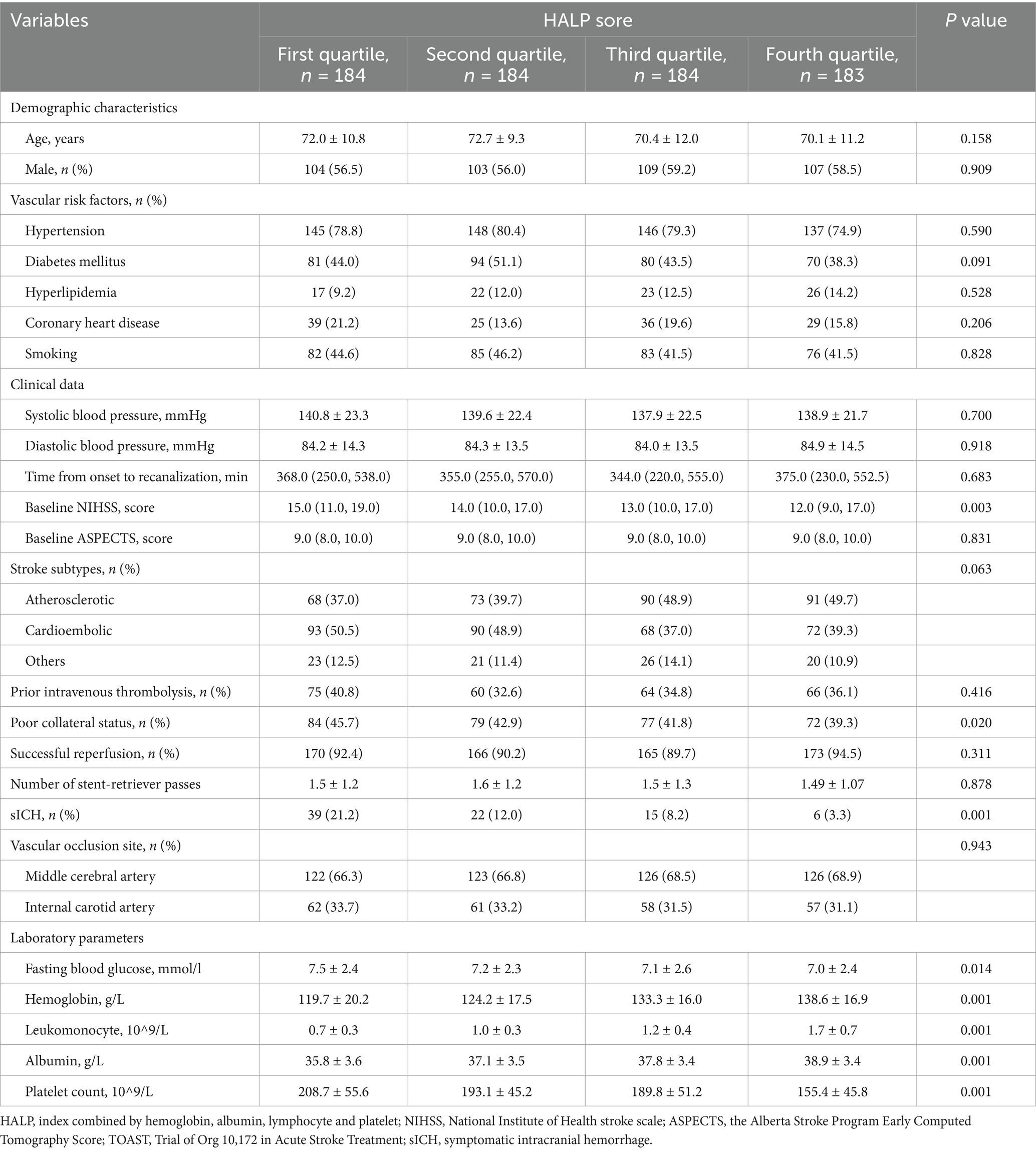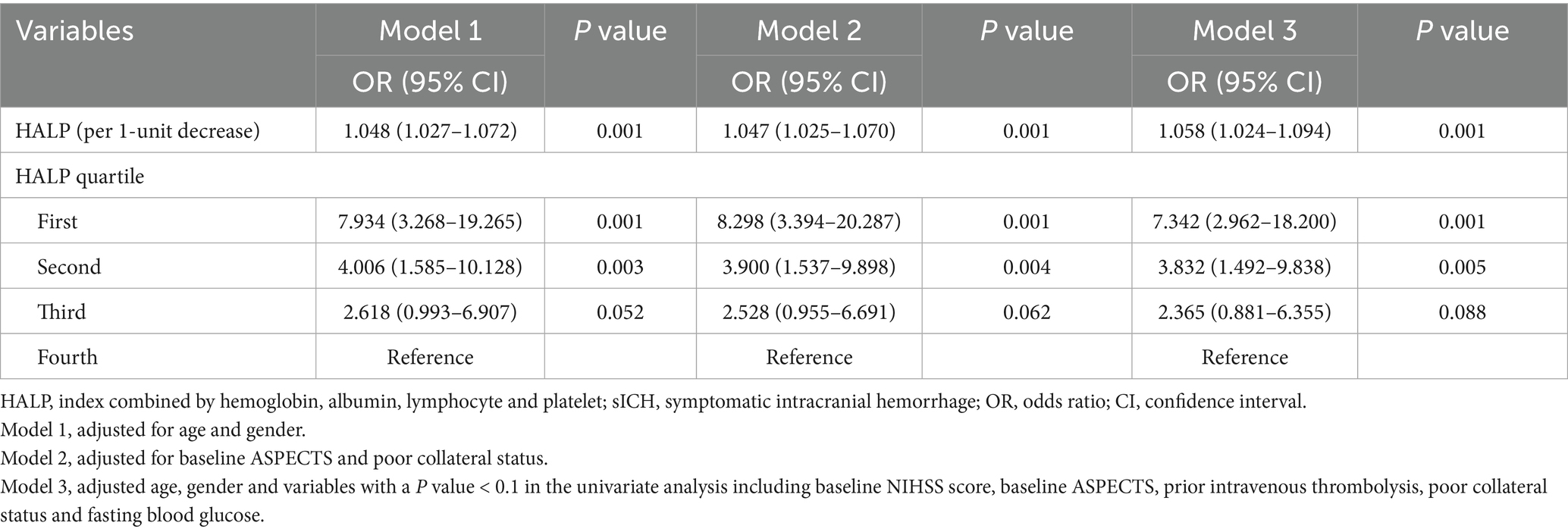- Department of Neurology, Nanjing First Hospital, Nanjing Medical University, Nanjing, Jiangsu, China
Background: The HALP index, a composite biomarker integrating hemoglobin, albumin, lymphocyte, and platelet parameters, reflects both immunological competence and nutritional status. We therefore conducted this retrospective analysis to assess the correlation between HALP score and the risk symptomatic intracranial hemorrhage (sICH) risk in patients receiving mechanical thrombectomy (MT).
Methods: This retrospective study included patients with acute ischemic stroke due to anterior circulation large vessel occlusion who underwent MT between October 2019 and July 2024. The HALP index was calculated based on admission laboratory parameters. The sICH was diagnosed according to Heidelberg Bleeding Classification criteria within 72 h post-procedure. Multivariate logistic regression analysis was performed to identify independent association between pretreatment HALP score and sICH risk after adjusting for covariates.
Results: A total of 735 patients (mean age, 71.3 ± 10.9 years; 423 male) were enrolled in this study. sICH was diagnosed in 82 patients (11.2%) during hospitalization. After adjusting for demographic characteristics and other covariates, multivariate logistic regression analysis revealed that a low HALP index was significantly associated with an elevated risk of sICH (odds ratio: 1.058, 95% confidence interval: 1.024–1.094, p = 0.001). findings were obtained when the HALP score was analyzed as a categorical variable. Additionally, the restricted cubic spline analysis confirmed a linear inverse relationship between the HALP index and the risk of sICH following MT (p = 0.551 for non-linearity).
Conclusion: Our data confirmed a significant inverse correlation between the HALP score and the sICH risk in patients treated with MT. This suggests that the HALP score may serve as a valuable tool for monitoring and managing sICH risk in ischemic stroke patients following reperfusion therapy.
1 Introduction
Ischemic stroke is a leading cause of disability and mortality worldwide, imposing substantial medical and financial burdens globally (1, 2). Numerous randomized controlled trials have established that mechanical thrombectomy (MT) is effective for ischemic stroke patients with large vessel occlusion in the anterior circulation (3). Symptomatic intracranial hemorrhage (sICH) is a serious complication following reperfusion therapy, strongly associated with neurological deterioration and poor functional outcomes (4, 5). Therefore, early and accurate prediction of sICH is essential for optimizing functional recovery after MT.
Stroke outcomes are influenced by a multitude of factors, including genetic predisposition, modifiable lifestyle choices, dietary patterns, and cardiometabolic conditions. Inflammatory processes play a significant role in these mechanisms. Extensive research has shown that lymphocytes can alleviate neuronal damage by regulating inflammatory responses and act as key immunomodulators during acute ischemic stroke (6). Beyond their role in thrombosis, platelets also contribute to the inflammatory response triggered by ischemic stroke, primarily through interactions between platelet receptors and endothelial or immune cells (7). The Thrombolysis in Stroke Patients registry, which included 7,533 stroke patients treated with intravenous thrombolysis, demonstrated that a lower platelet count was significantly associated with an increased risk of sICH, while a higher platelet count correlated with a greater risk of mortality (8). Additionally, malnutrition is linked to stroke-related complications. Previous studies have indicated that low hemoglobin levels can lead to cerebral hypoxia, mitochondrial dysfunction, and neuronal damage (9). Deficiencies in serum albumin have been associated with poorer 90-day outcomes in patients with large artery occlusive stroke following MT (10), partly due to reduced antioxidant capacity after ischemic injury. Recently, the HALP (hemoglobin, albumin, lymphocyte, and platelet) index has emerged as a validated marker for evaluating systemic inflammation and nutritional status (11). The HALP index has gained recognition as a novel predictor of clinical outcomes in various cancers (12) and has also been shown to predict stroke recurrence and cognitive impairment in ischemic stroke patients (13, 14). However, the relationship between the HALP score and sICH in patients undergoing thrombectomy remains unclear.
Therefore, we conducted this study to evaluate the association between the HALP index and the risk of sICH in ischemic stroke patients following MT.
2 Materials and methods
2.1 Subjects and study design
We retrospectively analyzed acute ischemic stroke patients who underwent MT at Nanjing First Hospital between October 2019 and July 2024 for large vessel occlusion in the anterior circulation. The inclusion criteria were as follows: (1) age 18 years or older; (2) presence of anterior circulation large vessel occlusion (internal carotid artery or middle cerebral artery M1/M2 segments); and (3) availability of data necessary for calculating the HALP score. To ensure the homogeneity of the study population, we excluded patients with malignant tumors or hematological disorders. All procedures performed in studies involving human participants were reviewed and approved by the Ethics Committee of Nanjing First Hospital. This study complies with the Declaration of Helsinki. Due to its retrospective nature; patient consent was waived by the Ethics Committee of Nanjing First Hospital. Patient data confidentiality was maintained in Nanjing First Hospital.
2.2 Baseline variables assessment
We collected data on demographic characteristics, vascular risk factors, imaging findings, procedural details, and laboratory results. The National Institutes of Health Stroke Scale (NIHSS) was used to evaluate baseline neurological deficits (15). The Alberta Stroke Program Early CT Score (ASPECTS) was applied to measure pre-treatment infarct volume (16). Stroke subtypes were classified according to the Trial of Org 10,172 in Acute Stroke Treatment (TOAST) criteria (17). Collateral circulation was evaluated using digital subtraction angiography and graded according to the American Society of Interventional and Therapeutic Neuroradiology/Society of Interventional Radiology (ASITN/SIR) scale, with grades 0–1 indicating poor collateral circulation and grades 2–4 representing moderate to excellent collateral circulation (18). Successful recanalization was defined as a modified Thrombolysis in Cerebral Infarction (mTICI) score of 2b–3 (19).
2.3 Measurement of HALP score
Fasting whole blood samples were collected within 24 h of admission and systematically processed for all laboratory analyses. The HALP index was calculated using the following formula: hemoglobin levels (g/L) × albumin levels (g/L) × lymphocyte counts (/L) / platelet counts (/L) (20).
2.4 Definition of sICH
sICH was diagnosed based on the Heidelberg Bleeding Classification within 72 h post-MT (21).
2.5 Statistical analysis
Quantitative variables were expressed as mean ± standard deviation (SD) or median (interquartile range [IQR]), depending on the distribution normality, while categorical variables were presented as frequencies (percentages). Continuous variables were compared using the Student’s t-test or Mann–Whitney U test, and categorical variables were analyzed using the chi-square test or Fisher’s exact test. Binary logistic regression analysis was conducted to assess the association between the HALP score and the likelihood of sICH. Model 1 was adjusted for age and sex; Model 2 was further adjusted for baseline ASPECTS and poor collateral circulation. In model 3, additional adjustments were made for demographic characteristics and variables with a p value <0.1 in the univariate analysis, including baseline NIHSS score, baseline ASPECTS, prior intravenous thrombolysis, poor collateral status, fasting blood glucose, hemoglobin, and lymphocyte count. Variance Inflation Factor (VIF) was used for evaluating multicollinearity between HALP and its components. Furthermore, the pattern and magnitude of the relationship between the HALP index and sICH risk were evaluated using restricted cubic splines with three knots (at the 5th, 50th, and 95th percentiles), adjusted for the covariates included in Model 3. We also used the receiver operating characteristic (ROC) curve analysis to detect the discriminative ability of the HALP index in predicting sICH.
All statistical analyses were performed using IBM SPSS Statistics (version 25.0) and R software (version 4.3.1). A two-tailed p value <0.05 was considered statistically significant in this study.
3 Results
3.1 Baseline characteristics
This study enrolled 735 consecutive ischemic stroke patients, with 57.6% being male and a mean age of 71.3 ± 10.9 years. Among them, 265 patients (36.1%) received intravenous thrombolysis prior to endovascular treatment (EVT). Poor collateral circulation was observed in 328 patients (44.6%), and successful reperfusion was achieved in 91.7% of cases. Table 1 provides detailed clinical data stratified by HALP quartiles. Significant differences were observed across HALP quartiles in baseline NIHSS scores, poor collateral circulation, and fasting blood glucose levels. However, demographic characteristics and vascular risk factors showed no significant differences among the groups.
3.2 Risk factors of sICH after MT
The mean HALP score among the study participants was 32.2. Based on the Heidelberg Bleeding Classification, 82 patients (11.2%) were diagnosed with sICH. Table 2 summarizes the age, sex, baseline clinical data, and laboratory findings of patients with and without sICH. Univariate analysis revealed that patients with sICH had higher NIHSS scores (median: 15.0 vs. 13.0; p = 0.044) and lower baseline ASPECTS scores (median: 8.0 vs. 9.0; p = 0.003) compared to those without sICH. Prior intravenous thrombolysis (46.3% vs. 34.8%; p = 0.040) and poor collateral circulation (62.2% vs. 42.4%; p = 0.001) were more common in patients with sICH than in those without. Additionally, patients with sICH exhibited higher fasting blood glucose levels (mean: 8.2 ± 2.35 mmol/L vs. 7.07 ± 2.41 mmol/L; p = 0.001) and lower hemoglobin concentrations (1.1 ± 0.4 g/L vs. 1.2 ± 0.6 g/L; p = 0.046) compared to those without sICH. The HALP index was significantly lower in patients with sICH than in those without (mean: 26.2 ± 13.4 vs. 32.8 ± 19.7; p = 0.001).
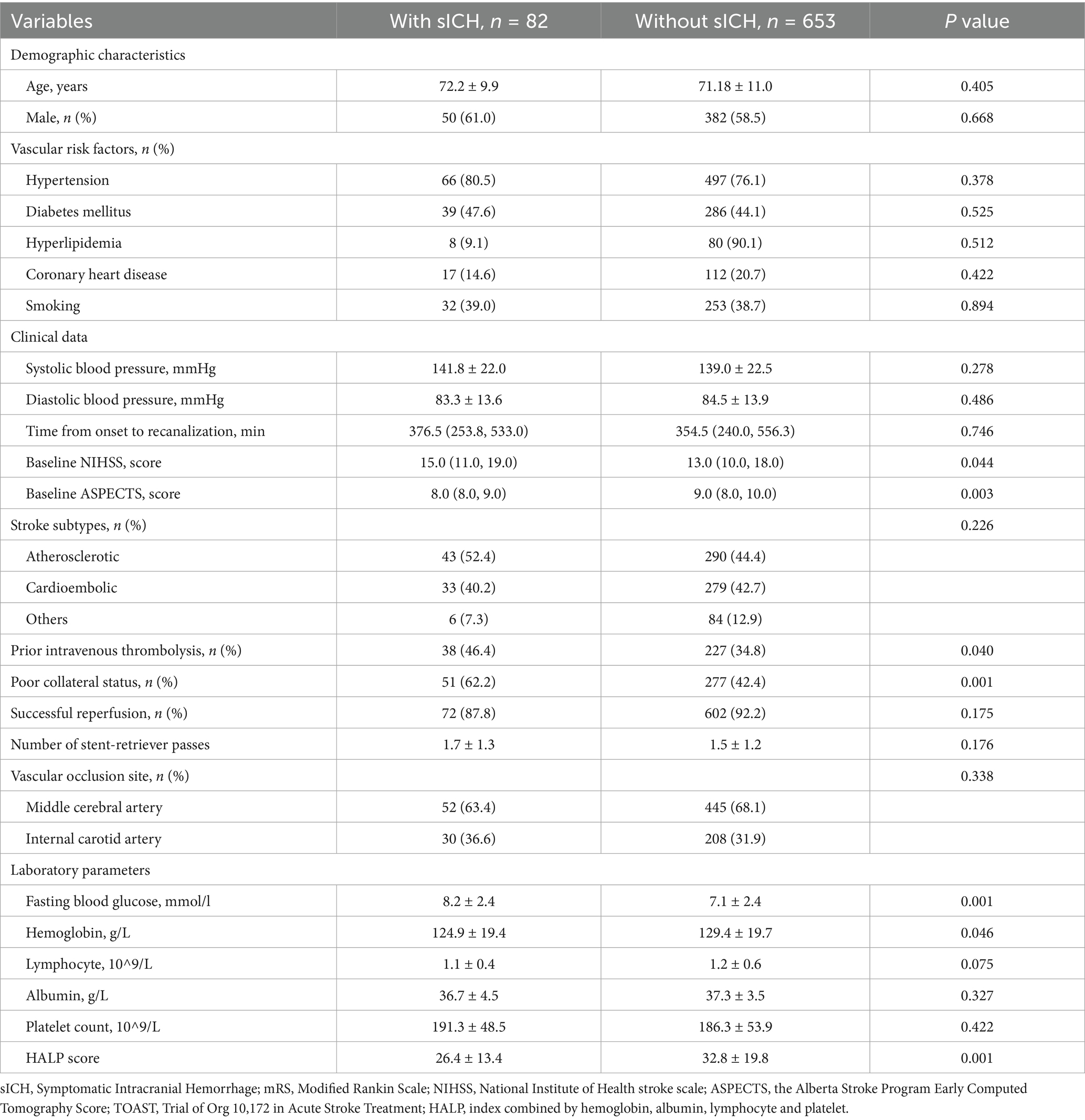
Table 2. Clinical characteristics of study participants according to patients with and without sICH.
3.3 Associations between HALP index and sICH risk
After adjusting for covariates, multivariate logistic regression analysis revealed that a higher HALP index was significantly associated with a reduced risk of sICH (odd ratios, 1.058; 95% confidence interval, 1.024–1.094, p = 0.001). These findings were further supported when the HALP index was analyzed as a categorical variable (1st quartile vs. 4th quartile of HAPL score, odd ratios, 7.342; 95% confidence interval, 2.962–18.200, p = 0.001; Table 3). Additionally, restricted cubic spline analysis confirmed a linear inverse relationship between the HALP index and sICH risk (p = 0.551 for non-linearity; p = 0.001 for linearity; Figure 1). In the ROC analysis, the area under the ROC curve values of the HALP index were 0.709 (95% CI: 0.657–0.761, p = 0.027; Figure 2). Also, the predictive ability of the HALP index is superior to baseline NIHSS score (AUC = 0.666), baseline glucose levels (AUC = 0.694), poor collateral status (AUC = 0.566), and prior IVT treatment (AUC = 0.512).
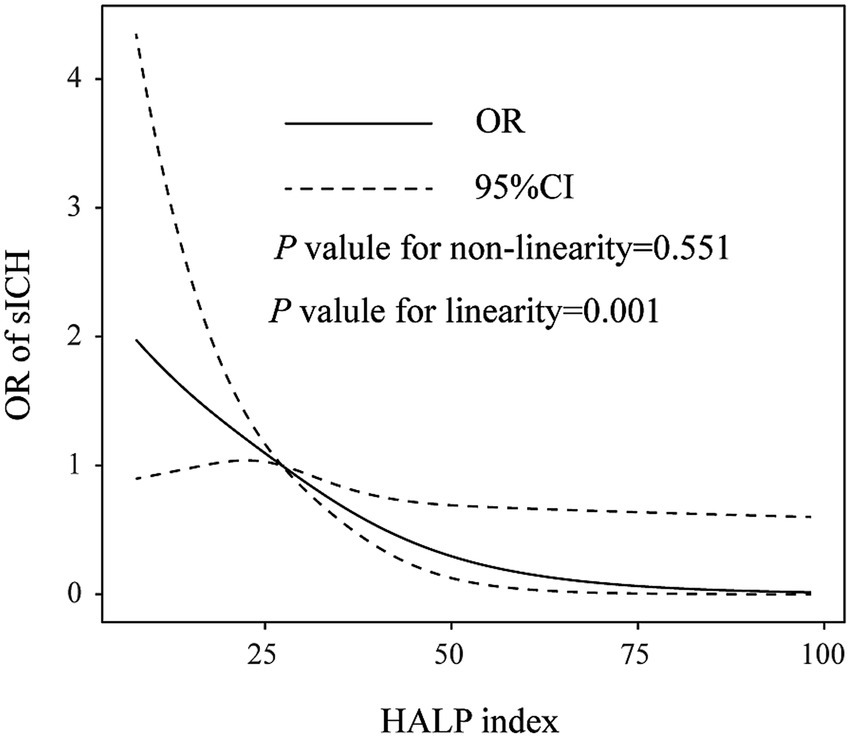
Figure 1. Restricted cubic spline plots depicting the relationships between the HALP score and the risk of sICH. Multivariable adjusted odds ratio (OR, represented by solid lines) and 95% confidence intervals (CI, represented by dotted lines) for the risk of sICH in model 3 are presented. The median value of the HALP score was designated as the reference.
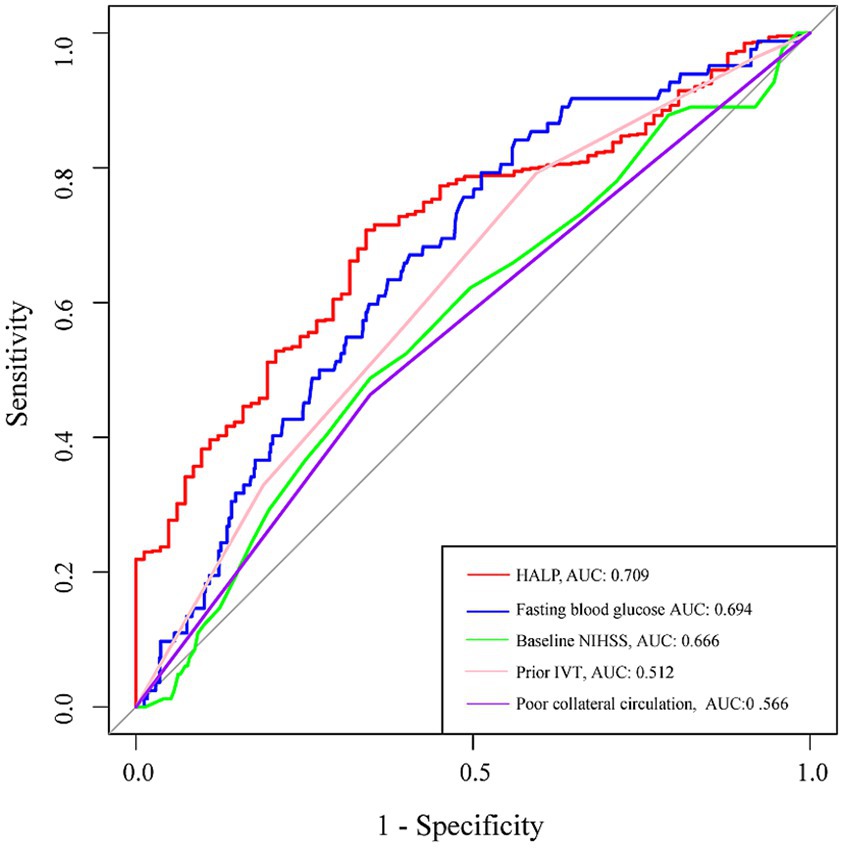
Figure 2. Receiver operating characteristic curve analysis evaluates the predictive value of HALP index and other established predictors for sICH.
4 Discussion
This study identified the HALP index as an independent predictor of sICH in patients with large artery occlusive stroke undergoing MT. This association remained significant even after adjusting for potential confounders, suggesting that the HALP index could serve as a modifiable risk factor for thrombectomy patients.
The HALP index, calculated from hemoglobin levels, albumin levels, lymphocyte counts, and platelet counts, reflects the interplay between inflammation and nutritional status. Previous clinical studies have demonstrated that a lower HALP index is strongly associated with an increased risk of cardiovascular diseases and overall mortality (22, 23). The HALP index also demonstrates a significant correlation with the risk of post-stroke cognitive impairment (24) and poor outcomes (13). Even though the underlying mechanisms connecting the HALP score and sICH remain unclear, the components of the index might shed light on these observations. Firstly, systemic inflammation is thought to be associated with increased endothelial dysfunction and the impairment of the blood—brain barrier following cerebral ischemia (25). Moreover, highly reactive platelets are indicative of a severe pro-inflammatory state (26, 27). Additionally, platelets can interact with platelet-binding T lymphocytes to produce cytokines, interferons, and chemokines. As a result, this interaction modifies the blood—brain barrier after a stroke (28). Secondly, lymphocytes assume pivotal regulatory functions in the inflammatory process subsequent to ischemic stroke (29). A decrease in lymphocyte levels has been associated with larger infarct volumes and higher NIHSS scores (30). Significantly, both of these factors are independent predictors of sICH (31). Thirdly, hypoalbuminemia contributes to the occurrence of sICH. It does so by intensifying the inflammatory response and oxidative stress (32), stimulating platelet aggregation (33), and enhancing cytokine adhesion within the postcapillary microcirculation (34). Finally, robust evidence demonstrates that reduced hemoglobin levels can give rise to brain hypoxia, mitochondrial dysfunction, and neuronal damage, thus increasing the risk of hemorrhage (9). Additional research is essential to thoroughly clarify the role of the HALP score in predicting the risk of sICH after reperfusion therapy.
We demonstrated that 82 patients (11.2%) experienced sICH during hospitalization. This percentage is slightly higher than the rates reported in several randomized controlled trials (3), as well as those observed in the MR CLEAN Registry (5.8%) (35) and the NASA Registry (9.9%) (36). The data in these registries were predominantly obtained from white populations. This disparity might be attributed to the higher prevalence of cerebral atherosclerosis in the Asian population. Intracranial atherosclerotic occlusion is often more difficult to recanalize successfully compared to cardioembolic occlusion, since the former is frequently associated with significant stenosis. Notably, in this study, a correlation was found between sICH and the number of passes made with the retriever. Repeated use of the thrombectomy device for atherosclerotic occlusion may lead to vascular endothelial damage and disrupt the blood–brain barrier, both of which are linked to an increased risk of sICH (37). However, differences in study methods and the definitions of sICH could potentially explain this discrepancy.
Several limitations in our study need to be acknowledged. First, there is an absence of clinical data on whether patients have pre-existing factors affecting the calculation of the HALP, such as a history of infection and medications. Secondly, given the nature of our study design, this research was unable to establish a causal relationship between HALP and the risk of sICH. Thirdly, the study failed to document whether the patients had been taking medications capable of influencing HALP scores prior to the commencement of the study. Examples of such medications include anti—platelet drugs and iron supplements. Finally, this research was executed at a solitary hospital in China and encompassed a particular cohort of cerebral infarction patients. This fact may potentially restrict the applicability and generalizability of the study findings. Consequently, multicenter studies involving large and diverse sample sizes are imperative to validate and strengthen our research findings.
In summary, this study clearly demonstrated that low HALP index was significantly associated with the risk of sICH in patients suffering from large artery occlusive stroke subsequent to MT therapy. The HALP score holds the potential to enhance the early and precisely-targeted treatment of stroke for these high-risk patients. Further research is essential to evaluate the potential effectiveness of dietary interventions and anti-inflammatory therapies in preventing sICH following MT treatment.
Data availability statement
The original contributions presented in the study are included in the article/supplementary material, further inquiries can be directed to the corresponding authors.
Ethics statement
The studies involving humans were approved by the Ethics Committee of Nanjing First Hospital. The studies were conducted in accordance with the local legislation and institutional requirements. The ethics committee/institutional review board waived the requirement of written informed consent for participation from the participants or the participants' legal guardians/next of kin due to the retrospective nature of the study.
Author contributions
SC: Conceptualization, Data curation, Formal analysis, Investigation, Methodology, Writing – original draft. ZH: Conceptualization, Data curation, Formal analysis, Investigation, Methodology, Resources, Validation, Visualization, Writing – original draft. JQ: Conceptualization, Data curation, Formal analysis, Investigation, Writing – original draft. BW: Data curation, Investigation, Methodology, Writing – original draft. YE: Conceptualization, Formal analysis, Methodology, Writing – original draft. CL: Methodology, Supervision, Conceptualization, Formal analysis, Project administration, Investigation, Resources, Software, Writing – review & editing. YZ: Conceptualization, Formal analysis, Funding acquisition, Investigation, Methodology, Supervision, Validation, Writing – review & editing. XZ: Conceptualization, Data curation, Formal analysis, Funding acquisition, Investigation, Methodology, Software, Writing – review & editing.
Funding
The author(s) declare that no financial support was received for the research and/or publication of this article.
Conflict of interest
The authors declare that the research was conducted in the absence of any commercial or financial relationships that could be construed as a potential conflict of interest.
Generative AI statement
The authors declare that no Gen AI was used in the creation of this manuscript.
Publisher’s note
All claims expressed in this article are solely those of the authors and do not necessarily represent those of their affiliated organizations, or those of the publisher, the editors and the reviewers. Any product that may be evaluated in this article, or claim that may be made by its manufacturer, is not guaranteed or endorsed by the publisher.
References
1. Wang, Y, Li, Z, Gu, H, Zhai, Y, Zhou, Q, Jiang, Y, et al. China stroke statistics: an update on the 2019 report from the National Center for healthcare quality Management in Neurological Diseases, China National Clinical Research Center for neurological diseases, the Chinese Stroke Association, National Center for chronic and non-communicable disease control and prevention, Chinese Center for Disease Control and Prevention and institute for global neuroscience and stroke collaborations. Stroke Vasc Neurol. (2022) 7:415–50. doi: 10.1136/svn-2021-001374
2. GBD 2019 Stroke Collaborators. Global, regional, and national burden of stroke and its risk factors, 1990-2019: a systematic analysis for the global burden of disease study 2019. Lancet Neurol. (2021) 20:795–820. doi: 10.1016/S1474-4422(21)00252-0
3. Goyal, M, Menon, BK, van Zwam, WH, Dippel, DW, Mitchell, PJ, Demchuk, AM, et al. Endovascular thrombectomy after large-vessel ischaemic stroke: a meta-analysis of individual patient data from five randomised trials. Lancet. (2016) 387:1723–31. doi: 10.1016/S0140-6736(16)00163-X
4. Zhang, M, Xing, P, Tang, J, Shi, L, Yang, P, Zhang, Y, et al. Predictors and outcome of early neurological deterioration after endovascular thrombectomy: a secondary analysis of the DIRECT-MT trial. J Neurointerv Surg. (2023) 15:e9–e16. doi: 10.1136/neurintsurg-2022-018976
5. Hao, Y, Yang, D, Wang, H, Zi, W, Zhang, M, Geng, Y, et al. Predictors for symptomatic intracranial hemorrhage after endovascular treatment of acute ischemic stroke. Stroke. (2017) 48:1203–9. doi: 10.1161/STROKEAHA.116.016368
6. Ren, X, Akiyoshi, K, Dziennis, S, Vandenbark, A, Herson, P, Hurn, P, et al. Regulatory B cells limit CNS inflammation and neurologic deficits in murine experimental stroke. J Neurosci. (2011) 31:8556–63. doi: 10.1523/JNEUROSCI.1623-11.2011
7. Cui, J, Li, H, Chen, Z, Dong, T, He, X, Wei, Y, et al. Thrombo-inflammation and immunological response in ischemic stroke: focusing on platelet-Tregs interaction. Front Cell Neurosci. (2022) 16:955385. doi: 10.3389/fncel.2022.955385
8. Gensicke, H, Al Sultan, AS, Strbian, D, Hametner, C, Zinkstok, SM, Moulin, S, et al. Intravenous thrombolysis and platelet count. Neurology. (2018) 90:e690–7. doi: 10.1212/WNL.0000000000004982
9. Wang, X, Mori, T, Sumii, T, and Lo, E. Hemoglobin-induced cytotoxicity in rat cerebral cortical neurons: caspase activation and oxidative stress. Stroke. (2002) 33:1882–8. doi: 10.1161/01.str.0000020121.41527.5d
10. Gao, J, Zhao, Y, Du, M, Guo, H, Wan, T, Wu, M, et al. Serum albumin levels and clinical outcomes among ischemic stroke patients treated with endovascular Thrombectomy. Neuropsychiatr Dis Treat. (2021) 17:401–11. doi: 10.2147/NDT.S293771
11. Liu, X, Qiu, Z, Ndhlovu, E, Wan, Y, Sun, H, Wang, S, et al. Establishing and externally validating a hemoglobin, albumin, lymphocyte, and platelet (HALP) score-based nomogram for predicting early recurrence in BCLC stage 0/a hepatocellular carcinoma patients after radical liver resection: a multi-center study. J Hepatocell Carcinoma. (2024) 11:1127–41. doi: 10.2147/JHC.S465670
12. Guo, Y, Shi, D, Zhang, J, Mao, S, Wang, L, Zhang, W, et al. The hemoglobin, albumin, lymphocyte, and platelet (HALP) score is a novel significant prognostic factor for patients with metastatic prostate Cancer undergoing Cytoreductive radical prostatectomy. J Cancer. (2019) 10:81–91. doi: 10.7150/jca.27210
13. Tian, M, Li, Y, Wang, X, Tian, X, Pei, L, Wang, X, et al. The hemoglobin, albumin, lymphocyte, and platelet (HALP) score is associated with poor outcome of acute ischemic stroke. Front Neurol. (2021) 11:610318. doi: 10.3389/fneur.2020.610318
14. Xu, M, Chen, L, Hu, Y, Wu, J, Wu, Z, Yang, S, et al. The HALP (hemoglobin, albumin, lymphocyte, and platelet) score is associated with early-onset post-stroke cognitive impairment. Neurol Sci. (2023) 44:237–45. doi: 10.1007/s10072-022-06414-z
15. Sucharew, H, Khoury, J, Moomaw, CJ, Alwell, K, Kissela, BM, Belagaje, S, et al. Profiles of the National Institutes of Health stroke scale items as a predictor of patient outcome. Stroke. (2013) 44:2182–7. doi: 10.1161/STROKEAHA.113.001255
16. Barber, PA, Demchuk, AM, Zhang, J, and Buchan, AM. Validity and reliability of a quantitative computed tomography score in predicting outcome of hyperacute stroke before thrombolytic therapy. ASPECTS study group. Alberta stroke Programme early CT score. Lancet. (2000) 355:1670–4. doi: 10.1016/S0140-6736(00)02237-6
17. Adams, HP Jr, Bendixen, BH, Kappelle, LJ, Biller, J, Love, BB, Gordon, DL, et al. Classification of subtype of acute ischemic stroke. Definitions for use in a multicenter clinical trial. TOAST. Trial of org 10172 in acute stroke treatment. Stroke. (1993) 24:35–41. doi: 10.1161/01.STR.24.1.35
18. Carvalho, A, Rocha, M, Rodrigues, M, Gregório, T, Costa, H, Cunha, A, et al. Time to reset the definition of successful revascularization in endovascular treatment of acute ischemic stroke. Cerebrovasc Dis. (2018) 46:40–5. doi: 10.1159/000491553
19. Zhang, X, Peng, M, Feng, C, Wang, H, Gong, P, Jiang, T, et al. Nomogram predicting early neurological improvement in ischaemic stroke patients treated with endovascular thrombectomy. Eur J Neurol. (2021) 28:152–60. doi: 10.1111/ene.14510
20. Chen, XL, Xue, L, Wang, W, Chen, HN, Zhang, WH, Liu, K, et al. Prognostic significance of the combination of preoperative hemoglobin, albumin, lymphocyte and platelet in patients with gastric carcinoma: a retrospective cohort study. Oncotarget. (2015) 6:41370–82. doi: 10.18632/oncotarget.5629
21. von Kummer, R, Broderick, JP, Campbell, BC, Demchuk, A, Goyal, M, Hill, MD, et al. The Heidelberg bleeding classification: classification of bleeding events after ischemic stroke and reperfusion therapy. Stroke. (2015) 46:2981–6. doi: 10.1161/STROKEAHA.115.010049
22. Pan, H, and Lin, S. Association of hemoglobin, albumin, lymphocyte, and platelet score with risk of cerebrovascular, cardiovascular, and all-cause mortality in the general population: results from the NHANES 1999-2018. Front Endocrinol (Lausanne). (2023) 14:1173399. doi: 10.3389/fendo.2023.1173399
23. Zheng, Y, Huang, Y, and Li, H. Hemoglobin albumin lymphocyte and platelet score and all-cause mortality in coronary heart disease: a retrospective cohort study of NHANES database. Front Cardiovasc Med. (2023) 10:1241217. doi: 10.3389/fcvm.2023.1241217
24. Zuo, L, Dong, Y, Liao, X, Hu, Y, Pan, Y, Yan, H, et al. Low HALP (hemoglobin, albumin, lymphocyte, and platelet) score increases the risk of post-stroke cognitive impairment: a multicenter cohort study. Clin Interv Aging. (2024) 19:81–92. doi: 10.2147/CIA.S432885
25. Evans, LE, Taylor, JL, Smith, CJ, Pritchard, HAT, Greenstein, AS, and Allan, SM. Cardiovascular comorbidities, inflammation, and cerebral small vessel disease. Cardiovasc Res. (2021) 117:2575–88. doi: 10.1093/cvr/cvab284
26. Reininger, AJ, Bernlochner, I, Penz, SM, Ravanat, C, Smethurst, P, Farndale, RW, et al. A 2-step mechanism of arterial thrombus formation induced by human atherosclerotic plaques. J Am Coll Cardiol. (2010) 55:1147–58. doi: 10.1016/j.jacc.2009.11.051
27. Viallard, JF, Solanilla, A, Gauthier, B, Contin, C, Déchanet, J, Grosset, C, et al. Increased soluble and platelet-associated CD40 ligand in essential thrombocythemia and reactive thrombocytosis. Blood. (2002) 99:2612–4. doi: 10.1182/blood.v99.7.2612
28. Salas-Perdomo, A, Miró-Mur, F, Urra, X, Justicia, C, Gallizioli, M, Zhao, Y, et al. T cells prevent hemorrhagic transformation in ischemic stroke by P-selectin binding. Arterioscler Thromb Vasc Biol. (2018) 38:1761–71. doi: 10.1161/ATVBAHA.118.311284
29. Baird, AE. The forgotten lymphocyte: immunity and stroke. Circulation. (2006) 113:2035–6. doi: 10.1161/CIRCULATIONAHA.105.620732
30. Kim, J, Song, TJ, Park, JH, Lee, HS, Nam, CM, Nam, HS, et al. Different prognostic value of white blood cell subtypes in patients with acute cerebral infarction. Atherosclerosis. (2012) 222:464–7. doi: 10.1016/j.atherosclerosis.2012.02.042
31. Dong, S, Yu, C, Wu, Q, Xia, H, Xu, J, Gong, K, et al. Predictors of symptomatic intracranial hemorrhage after endovascular Thrombectomy in acute ischemic stroke: a systematic review and Meta-analysis. Cerebrovasc Dis. (2023) 52:363–75. doi: 10.1159/000527193
32. Ishizaka, N, Ishizaka, Y, Nagai, R, Toda, E, Hashimoto, H, and Yamakado, M. Association between serum albumin, carotid atherosclerosis, and metabolic syndrome in Japanese individuals. Atherosclerosis. (2007) 193:373–9. doi: 10.1016/j.atherosclerosis.2006.06.031
33. Maalej, N, Albrecht, R, Loscalzo, J, and Folts, J. The potent platelet inhibitory effects of S-nitrosated albumin coating of artificial surfaces. J Am Coll Cardiol. (1999) 33:1408–14. doi: 10.1016/S0735-1097(98)00687-1
34. Belayev, L, Pinard, E, Nallet, H, Seylaz, J, Liu, Y, Riyamongkol, P, et al. Albumin therapy of transient focal cerebral ischemia: in vivo analysis of dynamic microvascular responses. Stroke. (2002) 33:1077–84. doi: 10.1161/hs0402.105555
35. van de Graaf, RA, Chalos, V, van Es, ACGM, Emmer, BJ, Lycklama À Nijeholt, GJ, van der Worp, HB, et al. Periprocedural intravenous heparin during endovascular treatment for ischemic stroke: results from the MR CLEAN registry. Stroke. (2019) 50:2147–55. doi: 10.1161/STROKEAHA.119.025329
36. Zaidat, O, Castonguay, A, Gupta, R, Sun, C, Martin, C, Holloway, W, et al. North American solitaire stent retriever acute stroke registry: post-marketing revascularization and clinical outcome results. J Neurointerv Surg. (2014) 6:584–8. doi: 10.1136/neurintsurg-2013-010895
Keywords: HALP index, large vascular occlusive stroke, symptomatic intracranial hemorrhage, mechanical thrombectomy, predictor
Citation: Chen S, Huang Z, Qi J, Wei B, E Y, Liu C, Zhang Y and Zhang X (2025) Low hemoglobin, albumin, lymphocyte, and platelet score increases symptomatic intracranial hemorrhage risk in thrombectomy patients. Front. Neurol. 16:1588875. doi: 10.3389/fneur.2025.1588875
Edited by:
Xintian Cai, Sichuan Academy of Medical Sciences and Sichuan Provincial People’s Hospital, ChinaReviewed by:
Qazi Zeeshan, University of Pittsburgh Medical Center, United StatesMohammed Ahmed Akkaif, QingPu Branch of Zhongshan Hospital Affiliated to Fudan University, China
Copyright © 2025 Chen, Huang, Qi, Wei, E, Liu, Zhang and Zhang. This is an open-access article distributed under the terms of the Creative Commons Attribution License (CC BY). The use, distribution or reproduction in other forums is permitted, provided the original author(s) and the copyright owner(s) are credited and that the original publication in this journal is cited, in accordance with accepted academic practice. No use, distribution or reproduction is permitted which does not comply with these terms.
*Correspondence: Chunmei Liu, bmpzZHl5eWxjbUAxNjMuY29t; Yingdong Zhang, emhhbmd5aW5nZG9uZ0Buam11LmVkdS5jbg==; Xiaohao Zhang, emhhbmd4aWFvaGFvQG5qbXUuZWR1LmNu
†These authors have contributed equally to this work
 Shuaiyu Chen
Shuaiyu Chen Zhihang Huang†
Zhihang Huang† Yingdong Zhang
Yingdong Zhang Xiaohao Zhang
Xiaohao Zhang